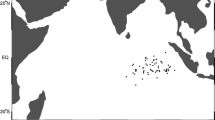Abstract
In order to determine the effect of twine thickness on the size-selectivity of the driftnet used for the yellow croaker, size-selectivity tests were conducted with three different twine thicknesses (monofilament diameters of 0.279 mm (number’s method; No. 3), 0.321 mm (No. 4), and 0.360 mm (No. 5)) of driftnets for the yellow croaker in the seas around Chooja-do, Jeju Islands. The selectivity curve was estimated by using Kitahara’s method. In order to determine the physical properties of the twine used in the experimental fishing nets, we measured the breaking load, elongation, and stiffness under both dry and wet conditions. In terms of physical properties, the thinnest twine (No. 3) had the strongest breaking strength per unit cross-sectional area, along with good elongation and excellent flexibility. The thickest twine (No. 5) had the lowest flexibility. In terms of selectivity, the net of No. 3 twine showed the broadest selection range and, thus, a relatively low selectivity compared with the other nets, while the less flexible net of No. 5 twine showed the narrowest selectivity range and high selectivity. In addition, it was found that a thicker twine resulted in a smaller haul of small fish. Therefore, it can be inferred that the thickness of the twine affects the size of the catch and selectivity, and thus the size composition of the catch as well.
Similar content being viewed by others
References
An H C, Bae J H, Kim S. 2013. Study on the size selectivity of a gillnet for Pacific herring (Clupea pallasii ) in the eastern sea of Korea. Journal of the Korean Society of Fisheries Technology, 49 (4): 360–367, http://dx.doi.org/10.3796/ KSFT.2013.49.4.360. (in Korean with English abstract)
Andres V B, Garrother P J G. 1964. Test Methods for Fishing Materials: Modern Fishing Gear of the World. 2 nd edn. Fishing News Books Ltd Press, New York. 49p.
Baranov F I. 1914. The capture of fish by gillnets. Mater. Poznoniyu Russ. Rybolov, 3: 56–99.
Fujimori Y, Tokai T, Hiyama S et al. 1996. Selectivity and gear efficiency of trammel nets for kuruma prawn (Penaeus japonicus ). Fisheries Research, 26 (1-2): 113–124, http:// dx.doi.org/10.1016/0165-7836(95)00392-4.
Fujimori Y, Tokai T. 2001. Estimation of gillnet selectivity curve by maximum likelihood method. Fisheries Science, 67 (4): 644–654, http://dx.doi.org/10.1046/j.1444-2906.2001.00301.x.
Hamley J M. 1975. Review of gillnet selectivity. Journal of the Fisheries Research Board of Canada, 32 (11): 1 943–1 969, http://dx.doi.org/10.1139/f75-233.
Hansen R G. 1974. Effect of different filament diameters on the selective action of monofilament gill nets. Transactions of the American Fisheries Society, 103 (2): 386–387, http:// dx.doi.org/10.1577/1548-8659(1974)103386:EODFDO2.0.CO;2.
Holst R, Wileman D, Madsen N. 2002. The effect of twine thickness on the size selectivity and fishing power of Baltic cod gill nets. Fisheries Research, 56 (3): 303–312, http://dx.doi.org/10.1016/S0165-7836(01)00328-9.
Hovgård H. 1996. Effect of twine diameter on fishing power of experimental gill nets used in Greenland waters. Canadian Journal of Fisheries and Aquatic Sciences, 53 (5): 1 014–1 017, http://dx.doi.org/10.1139/f96-023.
Kim S H, Lee J H. 2002. Mesh selectivity in trammel net for flat fish. Journal of the Korean Society of Fisheries Technology, 38 (2): 91–100, http://dx.doi.org/10.3796/ KSFT.2002.38.2.091. (in Korean with English abstract)
Kim S H, Park S W, Bae J H et al. 2009. Mesh selectivity of drift gill net for yellow croaker, Larimichthys polyactis, in the coastal sea of gageo-do. Korean Journal of Fisheries and Aquatic Sciences, 42 (5): 518–522, http://dx.doi. org/10.5657/kfas.2009.42.5.518. (in Korean with English abstract)
Kim S H, Park S W, Lee K et al. 2013. Characteristics on the fishing performance of a drift net for yellow croaker (Larimichthys polyactis ) in accordance with the thickness of a net twine. Journal of the Korean Society of Fisheries Technology, 49 (3): 218–226, http://dx.doi.org/10.3796/ KSFT.2012.49.3.218. (in Korean with English abstract)
Kim S H, Park S, Lee K. 2014. Fishing performance of an octopus minor net pot made of biodegradable twines. Turkish Journal of Fisheries and Aquatic Scien ces, 14: 21–30, http://dx.doi.org/10.4194/1303-2712-v14_1_03.
Kitahara T. 1968. On sweeping trammel net (Kogisasiami ) fishery along coast of the San’in district-III, mesh selectivity curve of sweeping trammel net for Branquillos. Bull. Japan Soc. Fish. Tech., 34: 759–763.
Lowry N, Robertson J H B. 1996. The effect of twine thickness on cod-end selectivity of trawls for haddock in the North Sea. Fisheries Research, 26 (3-4): 353–363, http://dx.doi. org/10.1016/0165-7836(95)00418-1.
MIFAFF. 2012. Annual report on the agricultural & fisheries, farming & fishing village and food industry. Ministry for Food, Agriculture, Forestry and Fisheries (MIFAFF). (in Korean)
Park C D, An H C, Cho S K et al. 2003. Size selectivity of gill net for male snow crab, Chionoecetes opilio. Journal of the Korean Society of Fisheries Technology, 39 (2): 143–151, http://dx.doi.org/10.3796/KSFT.2003.39.2.143. (in Korean with English abstract)
Turunen T. 1996. The effects of twine thickness on the catchability of gillnets for pikeperch (Stizostedion lucioperca (L.)). Annales Zoologici Fennici, 33 (3-4): 621–625.
Yokota K, Fujimori Y, Shiode D et al. 2001. Effect of thin twine on gill net size-selectivity analyzed with the direct estimation method. Fisheries Science, 67 (5): 851–856, http://dx.doi.org/10.1046/j.1444-2906.2001.00332.x.
Author information
Authors and Affiliations
Corresponding author
Additional information
Supported by the National Institute of Fisheries Science (No. R2015041)
Rights and permissions
About this article
Cite this article
Kim, S., Lim, J., Lee, K. et al. Effect of twine thickness on size-selectivity of driftnet for the yellow croaker Larimichthys polyactis in southwestern Sea of Korea. Chin. J. Ocean. Limnol. 34, 1199–1208 (2016). https://doi.org/10.1007/s00343-016-5107-0
Received:
Accepted:
Published:
Issue Date:
DOI: https://doi.org/10.1007/s00343-016-5107-0




